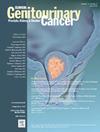初始相对剂量强度对先前治疗过的晚期尿路上皮癌的单药治疗的肿瘤反应和生存结果的影响:来自多中心研究的真实世界分析
IF 2.7
3区 医学
Q3 ONCOLOGY
引用次数: 0
摘要
目的:为治疗局部晚期或转移性尿路上皮癌(la/mUC)的前2 - 3个周期内,恩可图单抗维多汀(iRDI-EV)的初始相对剂量强度(RDI)与患者特征(包括ev不符合标准(EVITA)、肿瘤反应和生存)之间的关系提供真实证据。方法:一个多中心数据库登记了83例在2021年至2023年间接受晚期EV单药治疗的局部晚期或转移性患者。iRDI-EV是根据前2 ~ 3个周期的剂量变化计算的。在28天周期的第1、8和15天,1.25 mg/kg的剂量被认为是标准的完整方案。患者分为RDI-1(最低)、RDI-2、RDI-3和RDI完全(100% RDI)组。结果:共有68例患者可用于iRDI-EV分析和疗效评价。总体中位iRDI-EV为87%,4组中分别有14、13、13和28例患者的中位iRDI-EV分别为62%、73%、83%和100%。未观察到iRDI-EV与客观反应之间的明确关联。RDI-full组的疾病控制率(96%)明显高于其他组。高RDI组(RDI-3/RDI-full)患者的无进展生存期比低RDI组(RDI-1/RDI-2)更长,总生存期无差异。多元线性回归分析显示,较高的iRDI-EV是更好的反应和更长的生存期的重要因素。83例患者中,4例达到≥2 EVITA,表现出较高的进展风险,79例EVITA≤1。结论:肿瘤学家必须继续从晚期EV单药联合治疗的实际数据中学习。本文章由计算机程序翻译,如有差异,请以英文原文为准。
Impact of Initial Relative Dose Intensity on Tumor Response and Survival Outcomes in Enfortumab Vedotin Monotherapy for Previously Treated Advanced Urothelial Carcinoma: A Real-world Analysis From a Multicenter Study
Objective
To provide real-world evidence regarding the association between the initial relative dose intensity (RDI) of enfortumab vedotin (iRDI-EV) during the first 2 to 3 cycles for locally advanced or metastatic urothelial carcinoma (la/mUC) and patient characteristics, including EV-Ineligible criTeriA (EVITA), tumor response, and survival.
Methods
A multicenter database registered 83 patients with locally advanced or metastatic treated with late-line EV monotherapy between 2021 and 2023. The iRDI-EV was calculated based on the dose modification during the first 2 to 3 cycles. A dose of 1.25 mg/kg on days 1, 8, and 15 of a 28-day cycle was considered the standard full regimen. Patients were categorized into RDI-1 (lowest), RDI-2, RDI-3, and RDI-full (100% RDI) groups.
Results
In total, 68 patients were available for iRDI-EV analysis and response evaluation. The overall median iRDI-EV was 87%, with 14, 13, 13, and 28 patients in the 4 groups exhibiting median iRDI-EV of 62%, 73%, 83%, and 100%, respectively. No clear association between the iRDI-EV and objective response was observed. The disease control rate was significantly higher in the RDI-full group (96%) than in the other groups. The patients in higher RDI groups (RDI-3/RDI-full) had longer progression-free survival than the lower RDI groups (RDI-1/RDI-2), with no difference in overall survival. A multiple linear regression analysis revealed higher iRDI-EV was a strong contributor to better response and longer survival. Of the 83 patients, 4 met ≥2 EVITA, exhibiting a higher risk of progression, whereas 79 had EVITA ≤1.
Conclusions
Oncologists must continue to learn from real-world data on late-line EV monotherapy for combination therapy.
求助全文
通过发布文献求助,成功后即可免费获取论文全文。
去求助
来源期刊

Clinical genitourinary cancer
医学-泌尿学与肾脏学
CiteScore
5.20
自引率
6.20%
发文量
201
审稿时长
54 days
期刊介绍:
Clinical Genitourinary Cancer is a peer-reviewed journal that publishes original articles describing various aspects of clinical and translational research in genitourinary cancers. Clinical Genitourinary Cancer is devoted to articles on detection, diagnosis, prevention, and treatment of genitourinary cancers. The main emphasis is on recent scientific developments in all areas related to genitourinary malignancies. Specific areas of interest include clinical research and mechanistic approaches; drug sensitivity and resistance; gene and antisense therapy; pathology, markers, and prognostic indicators; chemoprevention strategies; multimodality therapy; and integration of various approaches.
 求助内容:
求助内容: 应助结果提醒方式:
应助结果提醒方式:


